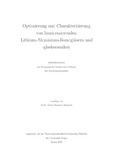Zitierlink:
http://dx.doi.org/10.25819/ubsi/9897Dateien zu dieser Ressource:
| Datei | Beschreibung | Größe | Format | |
|---|---|---|---|---|
| Dissertation_Charlotte_Rimbach.pdf | 22.92 MB | Adobe PDF |  Öffnen/Anzeigen |
| Dokumentart: | Doctoral Thesis | Titel: | Optimierung und Charakterisierung von lumineszierenden Lithium-Aluminium-Boratgläsern und -glaskeramiken | Sonstiger Titel: | Optimization and characterization of luminescent lithium-aluminium borate glasses and glass-ceramics | AutorInn(en): | Rimbach, Alicia Charlotte | Institut: | Department Physik | Schlagwörter: | In-situ-XRD, Quanteneffizienz, Glass Ceramic Material, Rare earth metal compounds, DSC | DDC-Sachgruppe: | 530 Physik | GHBS-Notation: | UIZ UIQM UIQD |
Erscheinungsjahr: | 2020 | Publikationsjahr: | 2021 | Zusammenfassung: | Lumineszierende Boratgläser und -glaskeramiken bieten eine vielversprechende Anwendungsmöglichkeit als temperaturstabile Lichtkonverter. In dieser Arbeit wird der Forschungsansatz verfolgt, mittels gezielter Netzwerkveränderung und Streuzentren die Effizienz des Leuchtstoffsystems zu verbessern. Zur Steigerung der Lichtausbeute werden die Gläser zu Glaskeramiken prozessiert, um die optische Weglänge durch Streuung an den gewachsenen Kristalliten im Glas zu erhöhen. Daher werden Glassysteme auf Basis von Lithium-Borat und Lithium-Aluminium-Borat mit den Seltenen Erdionen Eu3+, Tb3+ und Dy3+ als optische Aktivatoren hergestellt. Die Glassysteme werden mit Raman-Spektroskopie analysiert und thermisch durch dynamische Differenzkalorimetrie (DSC) sowie durch optische Spektroskopie charakterisiert. Der Kristallisationsprozess im Glas wird durch In-situ-Röntgenbeugung und DSC sowohl isotherm als auch nicht-isotherm betrachtet. Die Ergebnisse zeigen, dass die Lithiumkonzentration einen Einfluss auf die Nahfeldstruktur, den Glasübergang, die Kristallisationstemperatur sowie die Photolumineszenzeigenschaften des Glases hat. Der Anteil an Boroxol-Gruppen in der Nahfeldstruktur sinkt mit steigender Lithiumkonzentration. Zudem weist die Glasübergangstemperatur und damit die obere Grenze der Temperaturstabilität ein Maximum bei einem Lithium-zu-Bor-Verhältnis zwischen 1 : 3 und 1 : 4 auf. Bei zusätzlicher Dotierung mit Aluminiumoxid nimmt die Glasübergangstemperatur ab. Der Kristallisationspunkt verschiebt sich für beide Glassysteme mit zunehmender Lithiumkonzentration zu niedrigeren Temperaturen. Der Einfluss der Seltenen Erden auf Glasübergang und Kristallisation ist gering. Die Eu3+-dotierten Lithium-Boratgläser zeigen eine Photolumineszenz-Quanteneffizienz von fast 90 % (bei 396 nm), die Tb3+-dotierten von etwa 60 % (bei 486 nm) und die Dy3+-dotierten Gläser von etwa 30 % (388 nm). Diese Werte ergeben sich bei einem Lithium-zu-Bor-Verhältnis von 1 : 6. Wird die Lithiumkonzentration erhöht, so sinkt die Quanteneffizienz. Die Zugabe von Aluminiumoxid auf Kosten von Boroxid erleichtert die Glasherstellung und erhöht die Glasstabilität, verringert aber die Quanteneffizienz um bis zu 10 % gegenüber den aluminiumfreien Lithium-Boratgläsern. Ein Vergleich der Glasstabilitäten der untersuchten Glassysteme zeigt, dass sich ein Lithium-Aluminium-Boratglas mit einem Lithium-zu-Bor-Verhältnis von 1 : 2 am besten zur Glaskeramikherstellung eignet. Durch Tempern werden Li2B4O7- und Li2AlB5O10-Kristallite in den Gläsern erzeugt. Die Größe und der Anteil der erzeugten Kristallite im Glas kann über die Temperzeit, Tempertemperatur und Heizrate gesteuert werden. Optische Messungen an den Glaskeramiken zeigen, dass die Streueigenschaften monoton mit der Temperzeit wie gewünscht ansteigen. Luminescent borate glasses and glass ceramics offer a promising alternative as temperature-stable light converters. This work follows the research approach to improve the efficiency of the luminescent system by means of specific network changes and scattering centres. To increase the light output, the glasses are processed into glass ceramics to increase the optical path length by scattering on the grown crystallites in the glass. For this purpose, glass systems are produced on the basis of lithium borate and lithium-aluminium borate with the lanthanide ions Eu3+, Tb3+, and Dy3+ as optical activators. The glass systems are analyzed by Raman spectroscopy and by differential scanning calorimetry (DSC) as well as optical spectroscopy. The crystallization process in the glass is monitored by in situ X-ray diffraction and differential calorimetry, both isothermic and non-isothermic. The results show that the lithium concentration has an influence on the near-field structure, the glass transition, the crystallization temperature, and the photoluminescence properties of the glass. The amount of boroxole groups in the near-field structure decreases with increasing lithium concentration. In addition, the glass transition temperature and thus the upper limit of temperature stability shows a maximum at a lithium-to-boron ratio between 1 : 3 and 1 : 4. Additional doping with aluminium oxide leads to lower glass transition temperatures. The crystallization point for both glass systems shifts to lower temperatures as the lithium concentration increases. The influence of the doped lanthanide ions on glass transition and crystallization temperature is almost negligible. The Eu3+-doped lithium borate glasses show a quantum efficiency of almost 90% (at 396 nm), the Tb3+-doped glasses of about 60 % (at 486 nm), and the Dy3+-doped glasses of about 30 % (388 nm). These values are obtained for a lithium-to-boron ratio of 1 : 6. If the lithium concentration is increased, the quantum efficiency decreases. The addition of aluminium oxide at the expense of boron oxide facilitates glass production and increases glass stability, but reduces quantum efficiency by up to 10 % compared to the aluminium-free lithium borate glasses. A comparison of the glass stability of the glass systems studied shows that a lithium aluminium borate glass with a lithium-to-boron ratio of 1 : 2 is best suited for the production of glass ceramics. Thermal processing leads to the formation of Li2B4O7 and Li2AlB5O10 crystallites in the glasses. The size and amount of crystallites can be controlled over annealing time and annealing temperature as well as the heating rate. Optical studies on the glass ceramics show that the scattering properties increase monotonously upon prolonged thermal processing. |
DOI: | http://dx.doi.org/10.25819/ubsi/9897 | URN: | urn:nbn:de:hbz:467-18873 | URI: | https://dspace.ub.uni-siegen.de/handle/ubsi/1887 |
| Enthalten in den Sammlungen: | Hochschulschriften |
Diese Ressource ist urheberrechtlich geschützt. |
Seitenansichten
468
checked on 27.12.2024
Download(s)
425
checked on 27.12.2024
Google ScholarTM
Prüfe
Prüfe
Alle Ressourcen in diesem Repository sind urheberrechtlich geschützt, soweit nicht anderweitig angezeigt.

